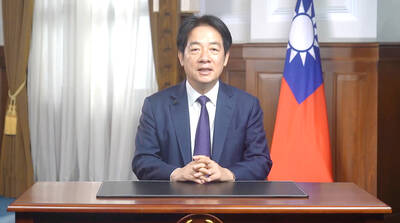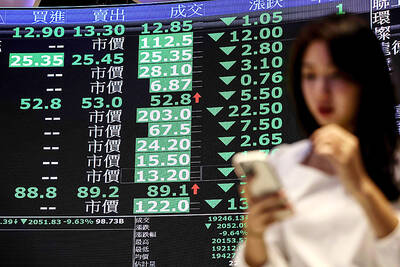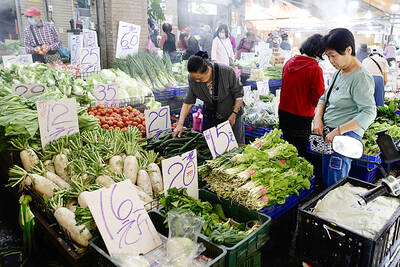The largest cultural exchange ever between Taiwan and China opened in Beijing yesterday with an exhibition of avant garde Taiwan-ese art.
"Visions of Pluralism: Contemporary Art in Taiwan, 1988-1999" by 75 Taiwanese artists is being shown at Beijing's Museum of Modern Art despite months of heightened tension.
Around 30 of the artists have come to the capital to show their works, some of which evoke Western pop art. One piece by Tang Huang-chen places two televisions beaming the same images opposite at each other.
Despite the crisis which erupted in July over President Lee Teng-hui's (李登輝) statement that Taipei-Beijing relations were conducted on a "special state-to-state" basis, the opening ceremony for the exhibition was formal, with China's vice minister of culture Meng Xiaosi attending.
"This exhibition had been planned for a year, well before the two-states theory row," explained Victoria Lu, a Taiwanese art critic and the show's curator. "We didn't know if it would go ahead or not, but the Taiwanese authorities were very supportive."
Although there are no official relations between the two governments, half of the show's cost was met by public funds from Taipei, Lu said.
Lin Cheng-chih (
"Culture is a means of dialogue that everybody understands," she said.
Lin cancelled his planned visit to Beijing at the last minute because of the 921 earthquake and not for political reasons, Lu said.
Exhibit organizers have done little to mask the fact that, except for a short period following World War II, the island has been politically separated from the mainland since the Japanese colonized it in 1895.
"Over 100 years of separation have generated undeniable differences between Taiwan and China," said Lu. "Separation from the mainland has endowed Taiwan with a very unique character and destiny."
She continued: "1988 was the beginning of a new era, in that it was the first year that the development of art became free from political control following the end of martial law in 1987."
The exhibition, which lasts 12 days, has received only sparse coverage by the mainland press.

ACTION PLAN: Taiwan would expand procurement from the US and encourage more companies to invest in the US to deepen bilateral cooperation, Lai said The government would not impose reciprocal tariffs in retaliation against US levies, President William Lai (賴清德) said yesterday, as he announced five strategies to address the issue, including pledging to increase Taiwanese companies’ investments in the US. Lai has in the past few days met with administrative and national security officials, as well as representatives from various industries, to explore countermeasures after US President Donald Trump on Wednesday last week announced a 32 percent duty on Taiwanese imports. In a video released yesterday evening, Lai said that Taiwan would not retaliate against the US with higher tariffs and Taiwanese companies’ commitments to

Intelligence agents have recorded 510,000 instances of “controversial information” being spread online by the Chinese Communist Party (CCP) so far this year, the National Security Bureau (NSB) said in a report yesterday, as it warned of artificial intelligence (AI) being employed to generate destabilizing misinformation. The bureau submitted a written report to the Legislative Yuan in preparation for National Security Bureau Director-General Tsai Ming-yen’s (蔡明彥) appearance before the Foreign Affairs and National Defense Committee today. The CCP has been using cognitive warfare to divide Taiwanese society by commenting on controversial issues such as Taiwan Semiconductor Manufacturing Co’s (TSMC, 台積電) investments in the

HELPING HAND: The steering committee of the National Stabilization Fund is expected to hold a meeting to discuss how and when to utilize the fund to help buffer the sell-off The TAIEX plunged 2,065.87 points, or 9.7 percent, to close at 19,232.35 yesterday, the highest single-day percentage loss on record, as investors braced for US President Donald Trump’s tariffs after an extended holiday weekend. Amid the pessimistic atmosphere, 945 listed companies led by large-cap stocks — including Taiwan Semiconductor Manufacturing Co (TSMC, 台積電), Hon Hai Precision Industry Co (鴻海精密) and Largan Precision Co (大立光) — fell by the daily maximum of 10 percent at the close, Taiwan Stock Exchange data showed. The number of listed companies ending limit-down set a new record, the exchange said. The TAIEX plunged by daily maxiumu in just

‘COMPREHENSIVE PLAN’: Lin Chia-lung said that the government was ready to talk about a variety of issues, including investment in and purchases from the US The National Stabilization Fund (NSF) yesterday announced that it would step in to staunch stock market losses for the ninth time in the nation’s history. An NSF board meeting, originally scheduled for Monday next week, was moved to yesterday after stocks plummeted in the wake of US President Donald Trump’s announcement of 32 percent tariffs on Taiwan on Wednesday last week. Board members voted to support the stock market with the NT$500 billion (US$15.15 billion) fund, with injections of funds to begin as soon as today. The NSF in 2000 injected NT$120 billion to stabilize stocks, the most ever. The lowest amount it